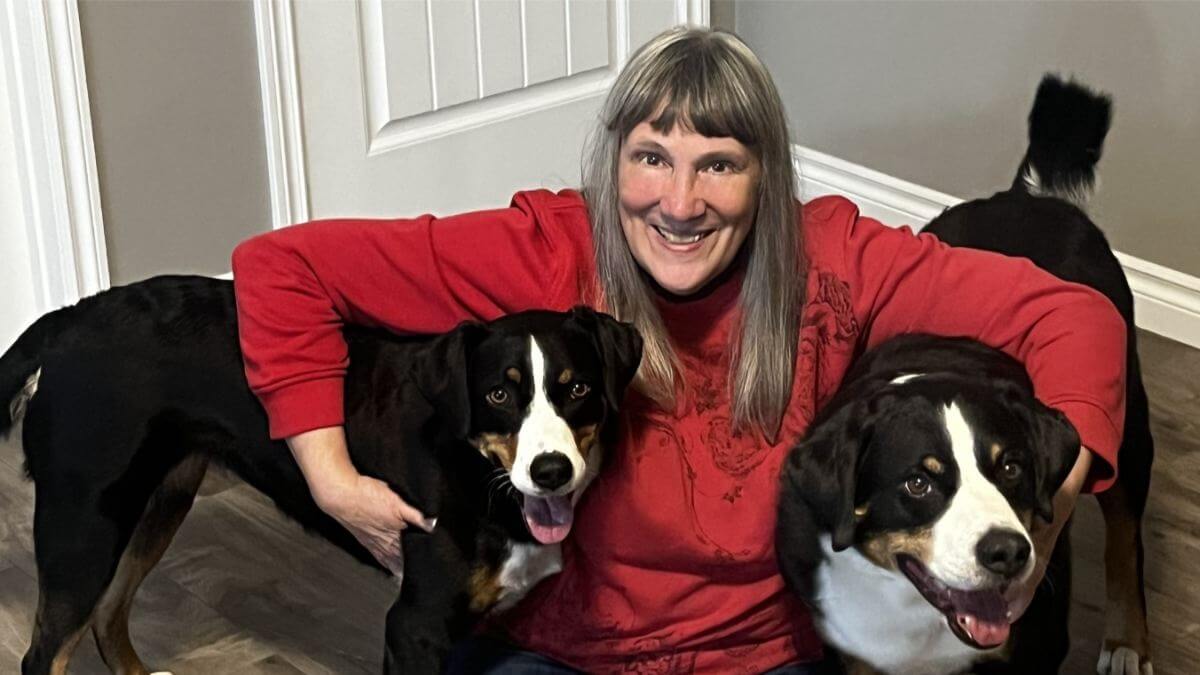
Home » Debbie Dales | Sun Meadow Appenzellers

Debbie Dales
1. I have been exhibiting and breeding dogs for over 12 years. In May of this year, I relocated to Stony Plain, Alberta, Canada, with my Appenzellers Rik (aka Ch Highleigh Ulric) and Dani (aka Daenerys von den Sommer Wald). I formerly resided in a small town called Deroche, located in the province of British Columbia, Canada, and was breeding under the kennel name of Deroche Appenzellers for 8 years. Because my partner in Deroche will continue to breed Appenzellers, I have changed my kennel name to Sun Meadow Appenzellers, hoping to minimize confusion among our Appenzeller family and friends.
Pugs were my breed of choice when I started breeding, and to help keep our Pugs safe, I wanted a larger dog presence on our property to help ward off the area’s many predatory animals and birds. I researched many dog breeds before discovering the Appenzeller
Sennenhund breed.
I concluded that Appenzellers:
These were the qualities I was looking for and could not have found a more suitable breed.
2. The expression “good things come to those who wait” could not be truer due to the rareness of the Appenzeller Sennenhund breed. I was not planning to breed Appenzellers, but because this is a rare breed and there are so few Appenzeller breeders in North America, I ended up doing just that.
Appenzellers are an extremely hard-working breed and require a great deal of physical and mental exercise to remain happy and healthy. Although an excellent herder and guarder of livestock, their high maintenance and high exercise requirements have limited their popularity in North America. Appenzellers are not a breed for everyone, particularly the first-time or inexperienced dog owner. A well-trained Appenzeller is a loyal and loving companion. Give him a job and provide good leadership, and he will be loyal and content.
3. Because the number of Appenzellers is still exceptionally low, there are very few being exhibited. So, most North American judges have not had the opportunity to evaluate Appenzellers in the Conformation show ring, and it is a rare opportunity for those judges who do. With so few Appenzellers in existence worldwide, it will take a long time to increase the population in North America before we see this breed fully recognized. Appenzellers have been listed with AKC Foundation Stock Services since 1996 and were recently listed with CKC in the Miscellaneous Group on July 1, 2023.
4. You are more likely to see an Appenzeller in the Performance ring, as they excel in all kinds of Performance activities.
5. Social media plays a significant role by providing real time events and educating the public. It is a great way to keep dog fanciers up to date on current events and provide live coverage of various dog sports such as Conformation, Agility, and many other Performance activities. I use social media to educate new and up-and-coming Appenzeller owners and to provide puppy updates. The AMDCA (Appenzell Mountain Dog Club of America) uses social media platforms, such as Instagram, Facebook, Twitter, etc., to provide information about “everything” Appenzeller.
Although social media is a great resource for information, there can be a lot of bashing at times and some people do have a difficult time with complainers and finger pointers. So, consequently, a number of my Appenzeller families and friends avoid social media.
6. The economy certainly has added challenges for the dog show community. Costs have increased exponentially in the past few years. Work commitments are keeping more people away from home for longer periods of time, leaving less time for them to spend with family pets, resulting in an excessive number of dogs ending up in shelters. As a result, community shelters are becoming increasingly more visible on social media, using slogans such as “adopt, don’t shop” and bashing purebred breeders in an effort to find homes for surrendered dogs.
As an exhibitor, economics has had a great affect on the number of dogs I show as well as the number of shows I attend. In addition, the CDC’s new import regulations restricting puppies under 6 months of age from entering into the US is another challenge that I face as a breeder. I have had to cancel a number of my litter plans because the demand for purebred companion dogs has declined, and I am unable to provide young puppies to our US customers. For these reasons, plans for my next up-and-coming show dog(s) have also been delayed.
7. When I started out as an exhibitor and breeder, health testing was not a regular practice even though test kits were available. Over the past few years, health testing has become routine with most breeders I know. Social media was a platform where most people shared pictures of their fancy dinners. Since then it has become an amazing educational platform that also provides us with dynamic live data.
It is clear that the purebred dog community is deeply committed to preserving the unique qualities of our breeds. As we navigate through the challenges we face, it is essential to remain hopeful and dedicated to our mission. By continuing to put in the effort and work together, we can ensure that the passion for preserving our breeds thrives and evolves positively over time.